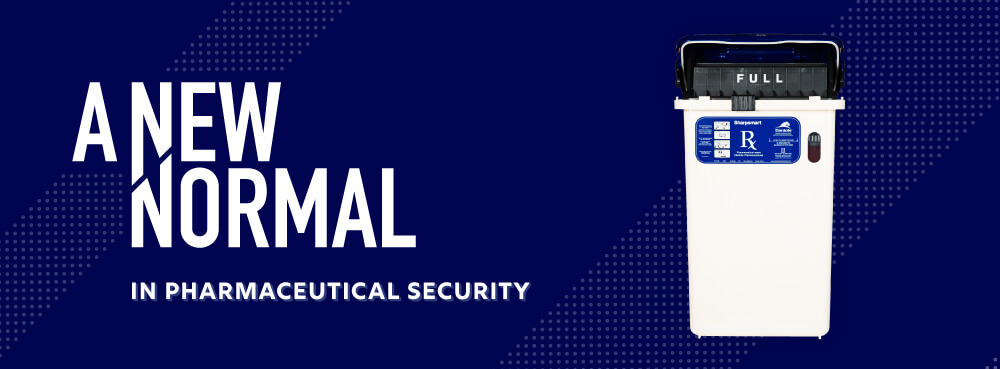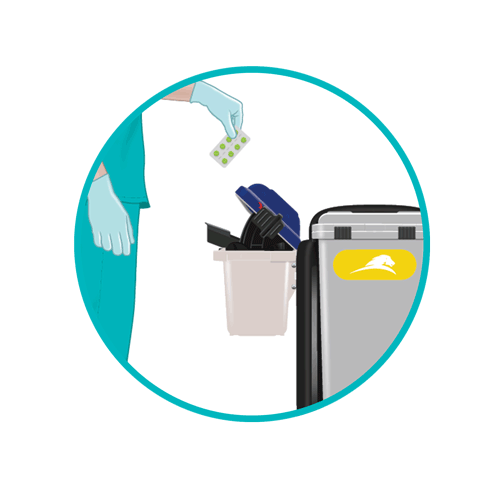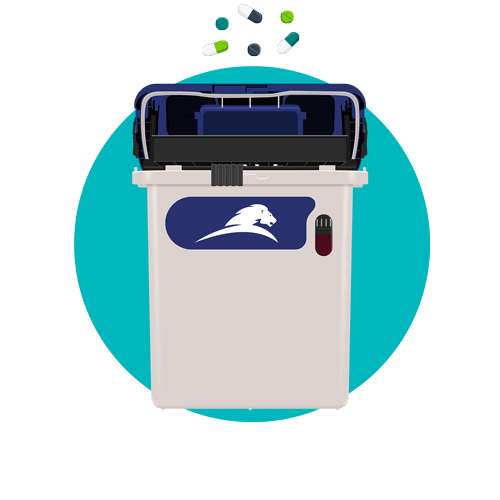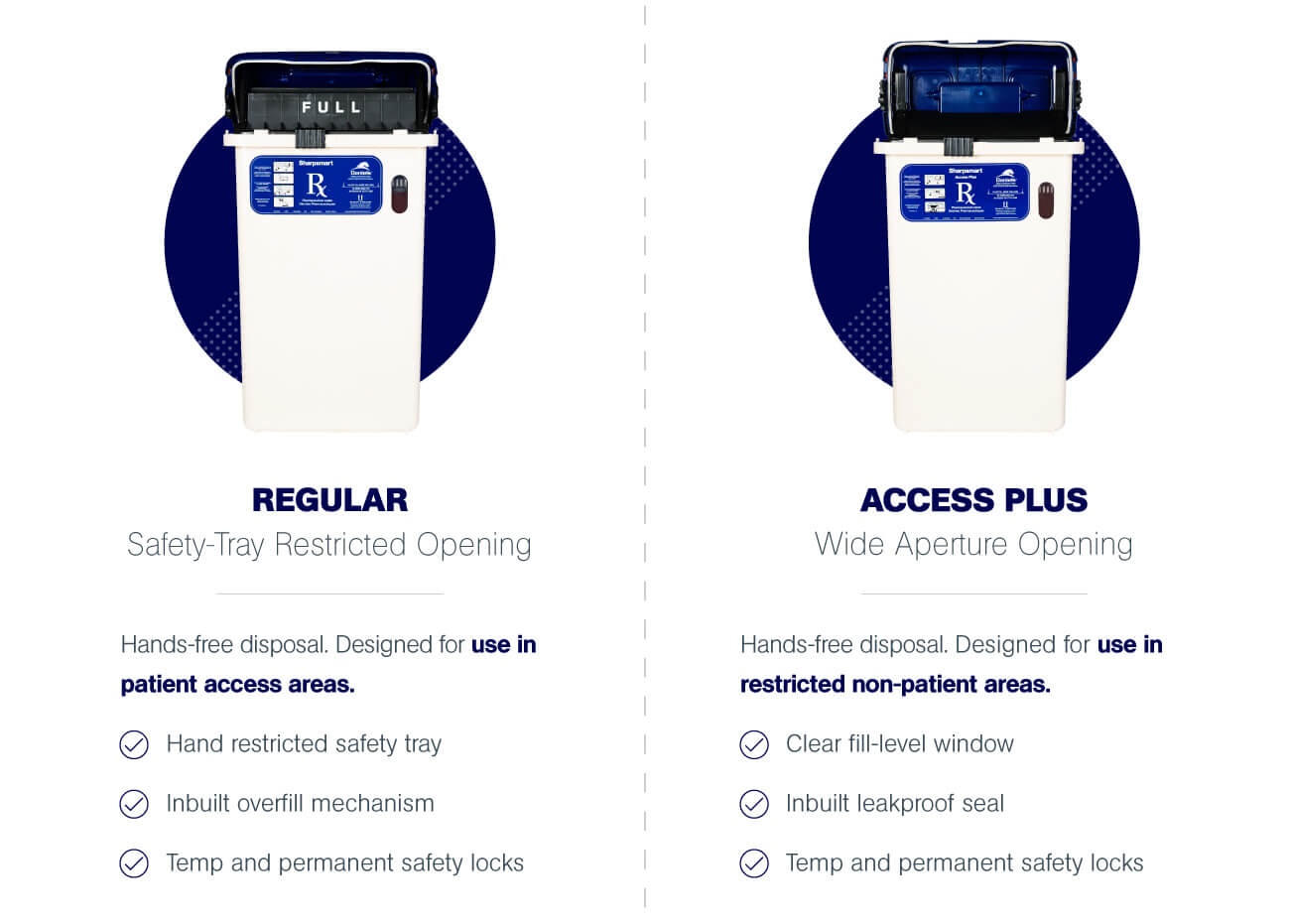A New Normal in Pharma Waste Security

Bring your pharmaceutical waste disposal into the modern era - by choosing a more secure pharmaceutical container.
In hospitals and patient-care facilities across Canada, Pharmaceutical waste is really the “waste de jour” of healthcare, as its handling, management and disposal falls under high risk environmental and public health scrutiny. Despite increasing regulatory guidance, and a national awakening in the risk in handling and disposing of this particular waste stream, the sophistication of disposal, particularly as it pertains to safety and security, has not increased in direct proportion. For the safety of healthcare workers and to remove ability for abuse in non-secure clinical areas, it is time to introduce a New Normal in the irretrievable containment of discarded pharmaceuticals.
Explore how we are creating #ANewNormal in pharmaceutical waste management:
- Understanding of the Risks
- Where security matters in non-hazardous pharmaceutical waste disposal
- How pharmaceutical container design impacts security
-
Environmental considerations for choosing a pharmaceutical container
Understanding Pharmaceutical Waste Risks
The Centers for Disease Control and Prevention estimates that the economic burden of prescribe opioid misuse in North America is over $78.5 billion a year1, and according to current data, Doctors and Nurses account for one of the highest rates of addiction in the workplace with more than 100,000 doctors, nurses, technicians and other health professionals struggling with addiction or abuse of narcotics.

At Daniels Health, our work within hospitals affords us a unique perspective of the risks and challenges that face clinicians in the handling and disposal of narcotics and medications.
- In facilities that don’t have clear segregation protocols in place, we see hazardous drugs mis-disposed into non-hazardous pharmaceutical containers.
- In the use of non-user-intuitive solutions for the denaturing of controlled substances, we often see tablets sitting unguarded on the top of the system
- In wards or departments that do not have adequate volume or placement of pharmaceutical containers, we see pharmaceuticals under-classified into regulated biomedical waste streams.
- In the use of pharmaceutical containers that are unsecured, we see containers go missing or accessed by unauthorized personnel
All of these scenarios pose not only risk to users within facilities where opioids are easily accessible for misuse, but also to downstream service staff handling waste, and finally to the detrimental impact to the environment if pharmaceuticals are not treated in an environmentally responsible way appropriate to the waste type and risk profile.
Where security matters in non-hazardous pharmaceutical waste disposal
The intent of this article is not to deep-dive into “what is pharmaceutical waste” and its classifications (you can find out more about that here), but rather to address the need for more modern thinking and solutions when it comes to opioid risk management. When scrutinizing your pharmaceutical waste program and examining the risks associated with your facility’s current workflow, here are some of the questions we would be asking?
- Are staff correctly trained in pharmaceutical waste disposal and segregation?
- Are your pharmaceutical containers located in secure areas?
- Are you utilising modern containment systems with inbuilt locks and tamper-proof security mechanisms?
- Are your pharmaceutical containers secured to a wall with locking systems that prevent unauthorised removal?
- Do you have a monitored process in place for witness destruction of controlled substances?
- Do you have security processes in place that restrict accessibility to disposed drugs?
A New Normal demands that we look at every aspect of pharmaceutical waste handling, including the security of the containers and systems that we use, to ensure the safeguarding of patients from unfettered temptation, as well as the protection of healthcare workers.
How pharmaceutical container design impacts security
Established to serve healthcare, our mantra at Daniels Health has always been to make healthcare safer through smart innovation that drives clinical outcomes. And in the case of pharmaceutical waste management, the driver for us was “how do we make a more secure pharmaceutical container that alleviates risk of unauthorised retrieval”?
Enter… the Pharmasmart. The first container of its kind designed to accommodate expired drugs and partially used non-hazardous pharmaceuticals, as well as syringes and sharp devices containing remnants of pharmaceutical drugs. The Pharmasmart’s clear ivory and blue colour coding distinctly differentiates it from hazardous waste (a black container), aiding in segregation of the two waste streams. But let’s talk first about security…
The design of the Non-Hazardous Medications "Pharmasmart" container
Determining container access protocols for where the containers are located
Daniels Pharmasmart containers have been designed with a full understanding of the needs of a clinical or pharmacy environment. Two unique container-lid opening mechanisms cater for both patient or "open access" environments where the prevalence of non-authorised personnel puts a greater risk on pharmaceutical theft, as well as secure environments where rapid deposition of medications is essential to a high intensity clinical workflow.
- When located in a patient-care or non-secure clinical or pharmacy environment. Regular P-Series Container
- When located in a surgery setting, locked pharmacy setting or secure clinical area. Access Plus P-Series Container

EXPLORE THE PHARMASMART FEATURES
OR if you don't have time to review the features, here in summary is how the Daniels Pharmasmart combats common secure risks associated with pharmaceutical waste disposal
- Secure wall mounting. Key access removal only, prevents unauthorised container removal
- Inbuilt safety tray restricts hand access and prevents drug retrieval
- Inbuilt permanent locks cannot be opened when locked, securing the waste
- Tamperproof, puncture-proof design eliminates sharps penetration risk
- Overfill safety mechanism prevents content-jamming and risk of overflow theft
-
Carts enable hands-free use and eliminate risk of exposure or injury
Environmental considerations for choosing a pharmaceutical container
So we’ve approached what a New Normal should look like to protect fellow humankind – safety and security, two fundamentals of what modern pharmaceutical waste containment should be based on. The third factor is sustainability. Three of the largest contributors to sustainability  burden from the pharmaceutical waste stream are:
burden from the pharmaceutical waste stream are:
- Disposable pharmaceutical containers / 33% + of the waste in disposal is the plastic of the container itself
- Over-classified pharmaceutical waste / the over-profiling of non-hazardous drugs results in more environmentally damaging treatment than what is required for that waste profile
- Under-classified pharmaceutical waste / the incorrect disposal of pharmaceuticals into non-pharmaceutical waste streams (trash or red bag waste) can result in landfill or waterway contamination.
Modern healthcare needs modern solutions that will provide safety to humans and the environment proportionate to risk. Whether this is a safer pharmaceutical container, an integrated education and compliance program, or the expert mapping and placement of containers for safe and effective segregation – we need to think differently about pharmaceutical risk.
The Pharmasmart is how we create #ANewNormal in pharmaceutical waste security
Speak to one of our experts today to explore how the Pharmasmart could be part of your New Normal, click here.
1 As Opioid Use Disorders Increased, Prescriptions for Treatment Did Not Keep Pace (NIDA Notes, July 2018)
